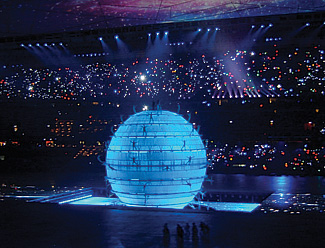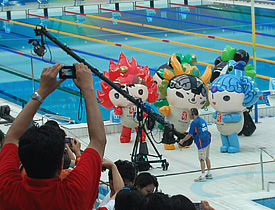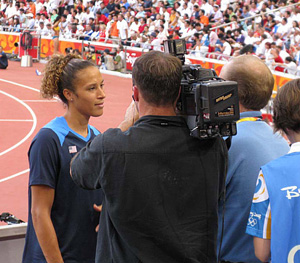Olympics Hits New Media
BEIJING
It takes years of preparation to reach the Olympics, and even more experience to tackle a perfect storm of new technological challenges. Such was the case in Beijing for Olympic veteran NBC, which had to produce the first true HD broadcast of a Summer Games simultaneously with the great unknowns associated with cranking out thousands of hours of content for new media outlets.

The broadcast was unprecedented. In Beijing, NBC produced 3,600 hours of coverage, more than the total coverage for every televised Summer Olympics in U.S. history combined.
A lot of content found its way onto one of several digital platforms—including 2200 hours of live streams on www.NBCOlympics.com, "replays" of network broadcasts and events, the largest cable VOD enterprise ever, clips-based content available on the Web, mobile phones and other platforms, and more.
The challenge went beyond volume. Throw potential political problems into the mix, and the general difficulty of working in a foreign country where English is not common, and the possibilities for a stressful broadcast were very real.
But the engineering and production teams systematically managed the technical hurdles they had control over, and the political challenges associated with broadcasting from China never materialized.
The result was what just about every staffer—many of them Olympic veterans—described as a top-notch, smooth event. China spared no resources to impress the world. NBC, through experience and long-range planning, produced a whole lot more content with staffing levels comparable to recent Summer Games. And, importantly, they did a lot of it from existing studios in the United States.
STAYING @HOME
The sheer quantity of the content NBC produced and controlled from home was huge. All of its cable shows and the shows produced for NBC-owned Telemundo were part of the "@home initiative," as it was called, with sites in New York, Florida and New Jersey. Also, other than ingest, the "Highlights Factory" clips production project really had a 30 Rock address (see Page 34).
"The @home guys did a great job," said David Mazza, senior vice president for engineering at NBC Olympics, in an interview conducted the day after closing ceremonies. "We heard very little from them for as busy as they were, and they were always on the air. It looked good and it sounded good."
NBC has been experimenting with split production for years, and technologies have caught up with what once were just engineering hopes. One critical example is sharing content and the use of proxy video.
The production process for a lot of the new media clips and promo content was backstopped by Omneon's ProCast CDN content distribution system, developed from Omneon's acquisition of Castify last year. Host feeds were ingested on NBC's MediaDeck using both high-res and low-res codecs to simultaneously create both full-resolution IMX or XDCAM HD files and low-res proxy files of all recordings. These files were transferred, while still being recorded, to the MediaGrid active storage system.
Here ProCast was used to transfer the proxies from Beijing to a second MediaGrid storage system in New York, where NBC @home producers could browse, view and edit the files. The EDLs created using the proxy files were then used to request only the desired SD and HD footage for transfer from Beijing to the United States, saving network bandwidth.
"The [ProCast] system worked great both in terms of file acceleration and the work rules," said Mazza. "It basically optimizes the file transfer using a suite of protocols and software so it could fully saturate the pipes it was feeding. … The Castify piece was critical to the whole thing."

A Panasonic P2 camera airborne, and a fan with his own gear, at the pool. Photo courtesy Panasonic From the operator standpoint, getting comms right is also key for split productions. In Beijing, operators could talk to a desk in New York as easily and at the same quality level as if the position were just a few hundred feet away.
Even though technical advances have begun to tame the task of doing a split production, workflow and volume issues remain. "The workflow at 30 Rock was very foreign to what typically
happens there," said Mazza. "They just don't do ten 'off-tube' sport calls off HD monitors from the floor of studio 8H typically, so keeping that all in sync was a worry. … It's hard enough when we're all in the same broadcast center, let alone extra locations."
One trial of note that took place in Beijing for possible use with the @home initiative moving forward was a workflow that involved NBC's Avids and Avid's Interplay asset management software. If @home in New York needed a large volume of media, rather than tying up the transmission line for several hours, Beijing personnel could take the clips on an Avid using its new Interplay software, transcode them down to proxies, and do a file transfer of the proxy from Beijing to Interplay in New York.
New York based personnel could look at the shots using an Interplay Assist station, select only the shots they really needed, then FTP that shot list back to Beijing requesting only perhaps 30 minutes of material rather than the initial two hours, saving transmission time.
"That was a very complex workflow we figured out but in the end we didn't use it as much as we anticipated," said Brian Longenecker, post production supervisor for NBC Olympics. "As it turned out, everyone was very good about selecting only the material they really needed, we didn't see the large two- or three-hour requests for material."
BIG LEAP INTO NEW MEDIA
While the broadcast side of the show in Beijing was not radically different than Torino in 2006, the new media side saw a radically ambitious increase in content over prior years.
NBCOlympics.com delivered 2,200 hours of live event video coverage, with more than 20 simultaneous live streams at times; more than 3,000 hours of on-demand video content including full-event replays, highlights, features, interviews and encore packages; an "enhanced playback mode" powered by Microsoft Silverlight that gave users the choice of a high-quality full-screen viewing experience or multiple windows of video; and metadata overlays powered by Silverlight that enabled fans to quickly access related content including results, stats, bios and more.
In addition to all this, a lot of the clips-based content was also formatted for SD and HD video-on-demand, mobile phone delivery, and electronic sell-through on sites like Amazon. "It's very complex, but we really set the groundwork [in Beijing]," said Dan Hogan, vice president for technology at NBC Sports and Olympics.
"The most interesting thing is how tied-in the broadcast is to all the online and new media ventures. The same systems are controlling broadcast that are controlling new media for repurposing for both."
Hogan said he was thrilled with how the streaming ventures went. "What surprised us is the spread [of viewership]. We thought we would get huge numbers on a U.S. basketball game or something like that, but our traffic has come from every single sport."
Hogan, who could monitor online traffic from his PC, said niche sports were getting surprisingly good online numbers, and the usual suspects such as a Phelps race or a U.S. gymnastics victory got the expected high traffic.

Heptathlete Jackie Johnson gives an interview. Photo courtesy Anton/Bauer Nielsen confirmed his observations, noting that the NBC Olympics Web site attracted strong audiences throughout the Games. Although trailing Yahoo's Olympic section very slightly in audience, all the effort at getting compelling video onto the Web must have paid off, as from an engagement perspective, "Visitors to NBC's site spent twice as much time and looked at three times more content when compared to Yahoo's online audience," said a Nielsen release.
Just having that good video content available was one factor, and NBC Web site visitors could also access up to four different video streams at once. Hogan said NBC testing had determined that for a large number of people to access video on today's Internet, the stream couldn't go above 700 kbps. With that in mind, the Digital Rapids encoders were set to send three streams, a 50 kbps, a 350 kbps and a 650 kbps stream.
While the 650 stream could be used as a single, high-quality full screen plus optional 50 kbps "picture in picture" mode, a 350
kbps coupled with up to three 50 kbps streams could be used for the "live video control room" four screens at once feature.
THE BIG BROADCAST
The new media efforts were in all respects an order of magnitude larger and more complex than what NBC had attempted at past Games. For the traditional broadcast side of the equation, the shift to a full HD broadcast was more an incremental change after the substantially HD broadcast in Torino.
NBC's all-HD IBC infrastructure in Beijing was actually less complex than Torino, where time constraints saw NBC decide to build an HD layer of equipment on top of the established SD layer it had been using for years.
"Torino had been a huge step for us because we had to transmit home in HD, the control rooms were HD, the recording devices were all HD," said Mazza. "For all intents and purposes that was our first big HD Olympics. Beijing was the first one where we had no SD, so it was actually a bit simpler than Torino because we eliminated the SD layer here and really just had an HD layer."
The HD standard coming from host broadcaster Beijing Olympic Broadcasting (BOB) was 1080i 50, which was converted to 60 Hz using Snell & Wilcox HD motion-compensated standards converters before final transmission to the United States. There, the SD feed needed for analog broadcast was derived from a 4:3 center cut of the 16:9 signal.
NBC estimated that about 15 to 20 percent of its network audience would be able to see the HD pictures, a figure more than 40 percent greater than in 2006.
But the bulk of the audience still got its TV in analog 4:3 SD form, so camera framing and graphics production protected the center portion of the HD frame.
HD RF ADVANCES
Beyond just a streamlined infrastructure, the two years since the last Games have seen HD refinements that made the job easier.
One example is HD RF cameras. David Peters, Olympic project manager for Total RF, said the technology had really started to come into its own in terms of signal quality and reliability just in time for Torino, and Beijing saw refinements to working systems. In Beijing eight RF cameras—a mix of Link and Gigawave units—were used at venues. Two more free roaming "digi backpacks" with receive sites at a central tower were used to cover events within the main Olympic thoroughfare.
Even more important, Beijing was the first Games NBC could tie its large deployment of EVS servers together with its Avids via file transfer, which is a technical feat that had just been achieved in SD before the switch to HD.
"I would say we are just getting back to where we were at the peak of SD [in terms of file transfers]," said Mazza.
What pieces of the HD production puzzle remain? Avid had only recently released software that allowed its machines to directly take in Long GOP video, such as that recorded by the XDCAM HD decks NBC used in Beijing.
The latest versions of Avid products support Long GOP, but NBC didn't really have time to explore the software before the Games and only a few of its Avid suites were Long GOP-capable.
Chip Adams, vice president for venue engineering at NBC Olympics, said cable run length at venues was a definite concern given the fact that HD cannot hold up over long runs.
"We made sure to put our TOC [Technical Operations Center] within 100 meters of the host TOC at each venue," said Adams. NBC also put in a reclocking DA in the host TOC to ensure proper level and good signals before it even reached the NBC TOC, said Adams.
Beyond dealing with HD, Beijing saw the exclusive use of flypacks—prefab buildings—rather than trucks at venues. This added to the complexity and logistical planning, as each venue had to be planned in terms of buildings, air conditioning, compound layout, power, and more.
"It's not like a truck where you pull up, you're given power, you pull out the sides, and you're ready to go," said Adams.
Acquisition also falls within Adams' purview, and he seemed pleased with what he had heard from the camera crews using Sony's new 4:2:2 PDW-700 XDCAM camcorders. "I did not hear one negative thing about the camcorder," said Adams. "For the size, the weight and the picture quality that comes out of it, it's a great system."
The camcorder had only became available a few months before the Games, which is a bit tight for NBC Olympic's engineers, who typically like to use very well established equipment at a Games.
The 189 PDW-1500 XDCAM record decks that showed in NBC's inventory system were workhorses in the ingest room and elsewhere. "I think we had two problems the whole time," said Mazza. "For a machine that was brand-spanking new that is impressive."
No matter how modern the equipment, or how much of it is available, Adams said the thing that stands out at any Games is the dedication and expertise NBC has found and nurtured in the freelance market.
The hard work paid off. Between the U.S. team doing well and the live element, ratings were good. NBC's broadcast of the Beijing Olympics drew more than 200 million viewers, making it the most watched television event in U.S. history over the 17 days. This meant a lot to the staff, said Mazza. "When there are glowing articles and your family and friends are saying 'everybody's captivated' it energizes the staff and that was a huge thing." Mazza said the fact that the ratings were the best since Atlanta (in 1996) was amazing.
"I know we did not beat the Atlanta ratings on a day-by-day basis, because with an on-shore Games it's all live and it's hard to beat that, but when comparing the overall numbers between Atlanta and here, the Internet was in its infancy back in 1996, there weren't nearly as many cable channels, digital cable, all the other options people have today," he said. "Network viewership back then was higher than now, so to get these numbers 12 years on from Atlanta is impressive."
Get the TV Tech Newsletter
The professional video industry's #1 source for news, trends and product and tech information. Sign up below.

